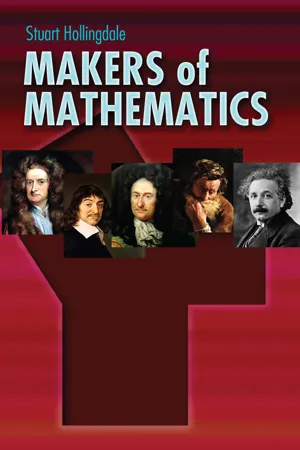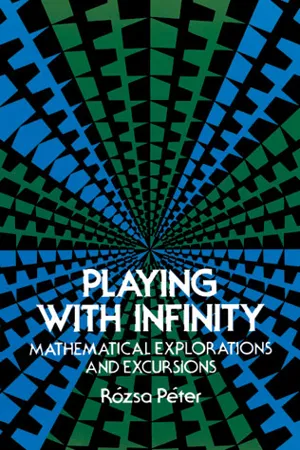Mathematics
Pascal's Triangle
Pascal's Triangle is a triangular array of numbers in which the first and last numbers of each row are 1, and each of the other numbers is the sum of the two numbers immediately above it. It is named after the French mathematician Blaise Pascal and has applications in probability theory, combinatorics, and algebra.
Written by Perlego with AI-assistance
Related key terms
5 Key excerpts on "Pascal's Triangle"
- eBook - ePub
Mindset Mathematics
Visualizing and Investigating Big Ideas, Grade 5
- Jo Boaler, Jen Munson, Cathy Williams(Authors)
- 2018(Publication Date)
- Jossey-Bass(Publisher)
Discuss how to write efficient expressions for the row sums. Then discuss the patterns in the row sums for the first Pascal's Triangle and for those with new starting numbers. Does the pattern hold?To the Teacher
Pascal's Triangle is a famous two-dimensional pattern of numbers arrayed in a triangular formation. At the top of the triangle is the number 1. Each number below is the sum of the two numbers above it.There are many patterns inside Pascal's Triangle—so many, in fact, that mathematicians believe that all the patterns have not yet been discovered. Patterns exist moving across, down, and within the triangle. You might discover interesting things in the triangle by looking at different kinds of numbers, such as odds or primes. Some of these patterns become clear only when the triangle is quite large—one reason that there is more to discover in Pascal's Triangle. In this puzzle, you'll want to encourage students to be inquisitive about the triangle, to try a hunch, and to simply ask, What would happen if …? We encourage you to investigate what patterns you notice in Pascal's Triangle by trying this activity yourself or, even better, with a group of teacher colleagues. We think you'll find this intriguing and even more engaging to teach if you explore first yourself.Because of the many avenues for puzzling and exploration in this activity, the lesson may be spread across multiple days. Follow your students' curiosity and give them the time they need.Activity
Launch
Start by showing students the image of Pascal's Triangle provided, which has some missing numbers. Tell students that this is a famous pattern of numbers called Pascal's Triangle, which has been found to have connections to lots of other math ideas. The triangle contains many patterns and can grow bigger and bigger following those patterns. There is a pattern to how to build this particular triangle. Ask, Can you find the pattern that builds the triangle so that you can fill in the blanks? - eBook - ePub
- Stuart Hollingdale(Author)
- 2014(Publication Date)
- Dover Publications(Publisher)
r at a time, is written asand is equal toThe denominator of this fraction is usually written as r! and called ‘r factorial’. SincenCrmust be a positive whole number, it follows that the product of any r consecutive positive integers is divisible by r! – an important result in the theory of numbers.Pascal made a thorough study of the properties of his triangle, in the course of which he gave the first clear exposition of the principle of mathematical induction. This principle, which asserts the validity of reasoning by recurrence, is now regarded as a fundamental axiom of modern mathematics. It may be stated thus: ‘If a property is true of the number 1, and is also true of the number n + 1 provided it is true of n, then it will be true of all whole numbers.’ Here is a simple example of a proof by induction. If we assume (p. 16) thatthenSince S(1) = 12 , the general result is established. Many properties of the numbers in Pascal’s triangle can be conveniently proved by induction. Such proofs rely heavily on a theorem, sometimes known as Pascal’s recurrence law, which asserts thatnCr+nCr-1=n+1Cr . This law (and other results in what is now called ‘combinatorial mathematics’) was skilfully exploited by the two correspondents. The build-up of their reasoning – to answer objections and to deal with ever more difficult problems, as the exposition passes from one man to the other and back again – makes compelling reading, but we must refer the interested reader to the letters themselves. (There are translations in Reference 8 - eBook - ePub
- Rózsa Péter(Author)
- 2012(Publication Date)
- Dover Publications(Publisher)
It follows from this that the sum of the terms in each row is double the sum of the terms in the previous row. For example let us construct the row after the last one we wrote down. It is done in the following way:and we can see clearly that in this row every term of the row 1 6 15 20 15 6 1 occurs exactly twice.This throws further light on another property of the Pascal Triangle: adding the terms of a row we obtain the successive powers of 2. Since this is the case in the beginning (apart from the uppermost 1) : i.e. 1 + 1 = 2 = 21 , 1 + 2 + 1 = 4 = 22 , we need not trouble to look any farther; if this property is true for one row, then it will be ‘inherited’ by the next row. We know that the sum of the terms of each row is twice as much as the sum of the terms in the previous row, and if we multiply any power of 2 by 2, we shall get a product 2 x 2 x 2 x ... 2 x 2 with one more 2 in it, i.e. we shall get the next power of 2.This kind of proof, which is based entirely on the construction of the natural number series, is called mathematical induction. The natural number series begins with 1, and by continuing to count one more, we can reach any member of the series. The idea of mathematical induction is simply that if something is true at the beginning of the number series, and if this is ‘inherited’ as we proceed from one number to the next, then it is also true for all natural numbers. This has given us a method to prove something for all natural numbers, whereas to try out all such numbers is impossible with our finite brains. We need prove only two things, both conceivable by means of our finite brains: that the statement in question is true for 1, and that it is the kind that is ‘inherited’.This is a most important lesson, namely that the infinite in mathematics is conceivable by means of finite tools. Those who like to play about with multiplications will be familiar with the first few rows in the Pascal Triangle. If we construct the powers of 11 successively, we find thatThe figures in the results are the very numbers in the Pascal Triangle. Those who had a good look at the multiplications will know straight away why this is so; when we added the partial products, we carried out just the same additions as in the construction of the rows in the Pascal Triangle (in the case of 115 - eBook - ePub
- Chen Chuan-Chong, Koh Khee-Meng(Authors)
- 1992(Publication Date)
- WSPC(Publisher)
Pascal triangle, after the renown French mathematician Blaise Pascal (1623-1662) who discovered it and made significant contributions to the understanding of it in 1653. The triangle is also called Yang Hui’s triangle in China as it was discovered much earlier by the Chinese mathematician Yang Hui in 1261. The same triangle was also included in the book “Precious Mirror of the Four Elements” by another Chinese mathematician Chu Shih-Chieh in 1303. For the history of the Pascal’s triangle, the reader may refer to the book [E].Figure 2.4.1.Figure 2.4.2.We now make some simple observations with reference to Figure 2.4.2 .(1) The binomial coefficient , located at the nth level from the top and rth position from the left, is the number of shortest routes from the top vertex representing to the vertex representing . This is identical to what we observed in Example 1.5.1 .(2) As = , the entries of the triangle are symmetric with respect to the vertical line passing through the vertex .(3) Identity (2.3.1) says that the sum of the binomial coefficients at the nth level is equal to 2n, and identity (2.3.6) says that the sum of the squares of the binomial coefficients at the nth level is equal to .(4) Identity (2.1.4), namely , simply says that each binomial coefficient in the interior of the triangle is equal to the sum of the two binomial coefficients on its immediate left and right “shoulders”. For instance, 21 = 15 + 6 as shown in Figure 2.4.2 .2.5. Chu Shih-Chieh’s IdentityWe proceed with another observation in Figure 2.4.2 . Consider the 5 consecutive binomial coefficients:along the NE line when r = 2 from the right side of the triangle as shown. The sum of these 5 number is 1 + 3 + 6 + 10 + 15 = 35, which is the immediate number we reach after turning left from the route 1-3-6-10-15. Why is this so? Replacing by - eBook - ePub
Tools to Help Your Children Learn Math
Strategies, Curiosities, and Stories to Make Math Fun for Parents and Children
- Alfred S Posamentier, Gavrielle Levine;Aaron Lieberman;Danielle Sauro Virgadamo(Authors)
- 2019(Publication Date)
- WSPC(Publisher)
The society in which he lived was tormented by religious upheaval, which to some extent affected Pascal as well, as his dear sister Jacqueline, who had supported him, entered a monastery in Pert-Royal and left him to live alone, something which he was not accustomed to. At age 23 he suffered a temporary paralysis, but his intellectuality continued unabated. He coninued to lead a rather turbulent life tortured by his family’s involvement in various religious followings. In 1654 at age 31, Pascal engaged in probably the most important contribution he had made to mathematics. That is, he embarked on a mathematical correspondence with Pierre de Fermat, which eventually became the basis for the theory of probability. During the year 1654, Pascal and Fermat challenged each other with mathematical problems that began to generate a thinking in probability, as we know it today. One of the early problems posed involved a game where two players would gain points, with a specified number of points to win the game.Figure 6.2: Pascal’s Calculating Machine Figure 6.3: The Pascal Triangle Showing Powers of 2Throughout this time Pascal made considerable use of the triangular arrangement of numbers that also bears his name today. In Figure 6.3 we see this arrangement, where beginning at the top with a 1, followed by a second row of two 1s, and each succeeding row begins with a 1 on each end, and each other number between the 1s is the sum of the two numbers above it on either side of it. This arrangement of numbers is known today as the Pascal triangle. Curiously, many number relationships can be found on the Pascal triangle. For example, the sum of the numbers in each row is a power of 2 as shown in Figure 6.3 .Figure 6.4: The Pascal Triangle Showing Powers of 11When we look at Figure 6.4 , we also notice that we have a representation of powers of 11. This triangular arrangement of numbers is very useful to this day when working with probability.It could be said, that Pascal’s name in today’s recollection of the history of mathematics is being a co-inventor of the theory of probability, which seems to become increasingly more important in our everyday lives from weather prediction to work in finance. On August 19, 1662, tortured with physical maladies and unpleasant mental conditions, Pascal’s life came to an end when he ended up with convulsions and died in Paris at age 39.
Learn about this page
Index pages curate the most relevant extracts from our library of academic textbooks. They’ve been created using an in-house natural language model (NLM), each adding context and meaning to key research topics.




